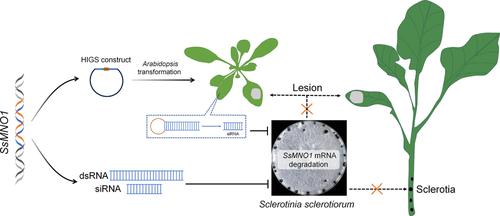当前位置:
X-MOL 学术
›
Pest Manag. Sci.
›
论文详情
Our official English website, www.x-mol.net, welcomes your
feedback! (Note: you will need to create a separate account there.)
RNA interference‐mediated targeting of monooxygenase SsMNO1 for controlling Sclerotinia stem rot caused by Sclerotinia sclerotiorum
Pest Management Science ( IF 3.8 ) Pub Date : 2024-11-18 , DOI: 10.1002/ps.8546 Lili Han, Yali Li, Zihong Yuan, Jing Wang, Binnian Tian, Anfei Fang, Yuheng Yang, Chaowei Bi, Yang Yu
Pest Management Science ( IF 3.8 ) Pub Date : 2024-11-18 , DOI: 10.1002/ps.8546 Lili Han, Yali Li, Zihong Yuan, Jing Wang, Binnian Tian, Anfei Fang, Yuheng Yang, Chaowei Bi, Yang Yu

|
BACKGROUNDSclerotinia sclerotiorum is a devastating fungal pathogen that poses a threat to a variety of economically important crops. Owing to the lack of highly resistant cultivars and the prolonged survival of sclerotia, effective control of Sclerotinia diseases remains challenging. RNA interference (RNAi) agents targeting essential active transcripts of genes associated with the development and virulence of pathogens are a valuable and promising disease control method.RESULTSOur finding suggested that a flavin adenine dinucleotide (FAD)‐dependent monooxygenase gene SsMNO1 plays pivotal roles in the hyphal growth, sclerotial development, and virulence of S. sclerotiorum , rendering it a potential target for RNAi‐mediated management of S. sclerotiorum . The external application of double‐stranded RNA (dsRNA) targeting SsMNO1 inhibited sclerotial development in artificial media and plant tissues. Furthermore, dsRNA significantly reduced the hyphal virulence of S. sclerotiorum in host plants by interfering with SsMNO1 expression. The inhibitory activity persisted for over 1 week on the surface of Brassica napus . Artificial small interfering RNA (siRNA) targeting SsMNO1 also exhibited inhibitory effects. Transgenic Arabidopsis thaliana plants expressing SsMNO1 hairpin RNAi constructs showed increased resistance to S. sclerotiorum infection. Notably, the total RNA extracts from SsMNO1‐ RNAi plants also reduced the hyphal virulence in Brassica napus .CONCLUSIONSTherefore, RNAi agents targeting SsMNO1 have dual effects on sclerotial development and hyphal virulence, rendering it an ideal target for controlling diseases caused by S. sclerotiorum . © 2024 Society of Chemical Industry.
中文翻译:

RNA 干扰介导的单加氧酶 SsMNO1 靶向控制由菌核病引起的菌核病茎腐病
背景菌核菌是一种毁灭性的真菌病原体,对各种具有重要经济价值的作物构成威胁。由于缺乏高抗性品种和菌核的存活时间延长,有效控制菌核病仍然具有挑战性。靶向与病原体发育和毒力相关的基因的基本活性转录物的 RNA 干扰 (RNAi) 试剂是一种有价值且有前途的疾病控制方法。结果我们的研究结果表明,黄素腺嘌呤二核苷酸 (FAD) 依赖性单加氧酶基因 SsMNO1 在菌核链球菌的菌丝生长、菌核发育和毒力中起关键作用,使其成为 RNAi 介导的菌核链球菌管理的潜在靶点。靶向 SsMNO1 的双链 RNA (dsRNA) 的外部应用抑制了人工培养基和植物组织中的硬化发育。此外,dsRNA 通过干扰 SsMNO1 表达显著降低寄主植物中菌核的菌丝毒力。抑制活性在甘蓝型油菜表面持续 1 周以上。靶向 SsMNO1 的人工小干扰 RNA (siRNA) 也表现出抑制作用。表达 SsMNO1 发夹 RNAi 构建体的转基因拟南芥植物对菌核链球菌感染的抵抗力增加。值得注意的是,来自 SsMNO1-RNAi 植物的总 RNA 提取物也降低了甘蓝型油菜中的菌丝毒力。结论迄今为止,靶向 SsMNO1 的 RNAi 药物对菌核发育和菌丝毒力具有双重作用,使其成为控制 S. scernrotiorum 引起的疾病的理想靶点。© 2024 化工学会.
更新日期:2024-11-18
中文翻译:

RNA 干扰介导的单加氧酶 SsMNO1 靶向控制由菌核病引起的菌核病茎腐病
背景菌核菌是一种毁灭性的真菌病原体,对各种具有重要经济价值的作物构成威胁。由于缺乏高抗性品种和菌核的存活时间延长,有效控制菌核病仍然具有挑战性。靶向与病原体发育和毒力相关的基因的基本活性转录物的 RNA 干扰 (RNAi) 试剂是一种有价值且有前途的疾病控制方法。结果我们的研究结果表明,黄素腺嘌呤二核苷酸 (FAD) 依赖性单加氧酶基因 SsMNO1 在菌核链球菌的菌丝生长、菌核发育和毒力中起关键作用,使其成为 RNAi 介导的菌核链球菌管理的潜在靶点。靶向 SsMNO1 的双链 RNA (dsRNA) 的外部应用抑制了人工培养基和植物组织中的硬化发育。此外,dsRNA 通过干扰 SsMNO1 表达显著降低寄主植物中菌核的菌丝毒力。抑制活性在甘蓝型油菜表面持续 1 周以上。靶向 SsMNO1 的人工小干扰 RNA (siRNA) 也表现出抑制作用。表达 SsMNO1 发夹 RNAi 构建体的转基因拟南芥植物对菌核链球菌感染的抵抗力增加。值得注意的是,来自 SsMNO1-RNAi 植物的总 RNA 提取物也降低了甘蓝型油菜中的菌丝毒力。结论迄今为止,靶向 SsMNO1 的 RNAi 药物对菌核发育和菌丝毒力具有双重作用,使其成为控制 S. scernrotiorum 引起的疾病的理想靶点。© 2024 化工学会.


















































 京公网安备 11010802027423号
京公网安备 11010802027423号